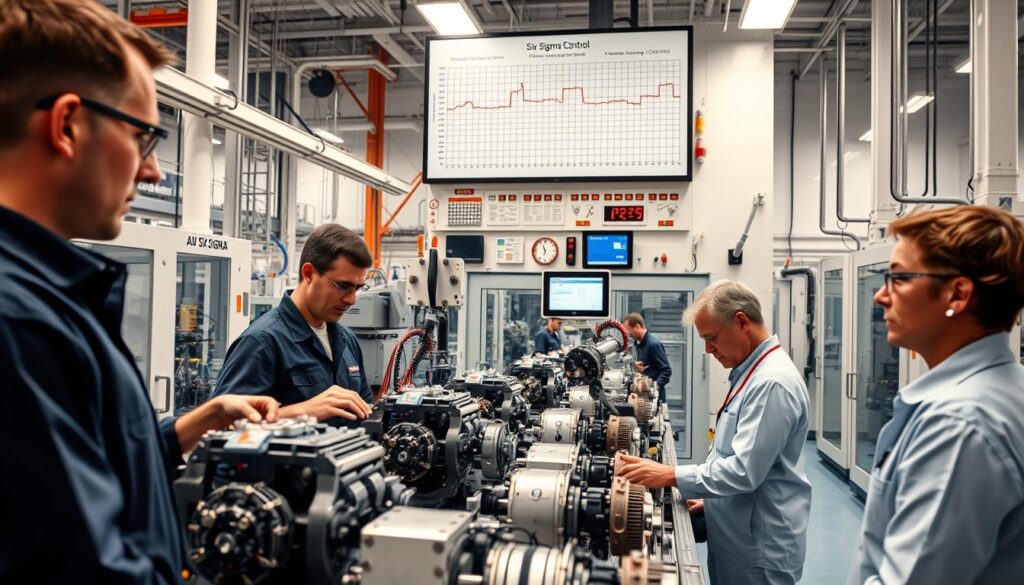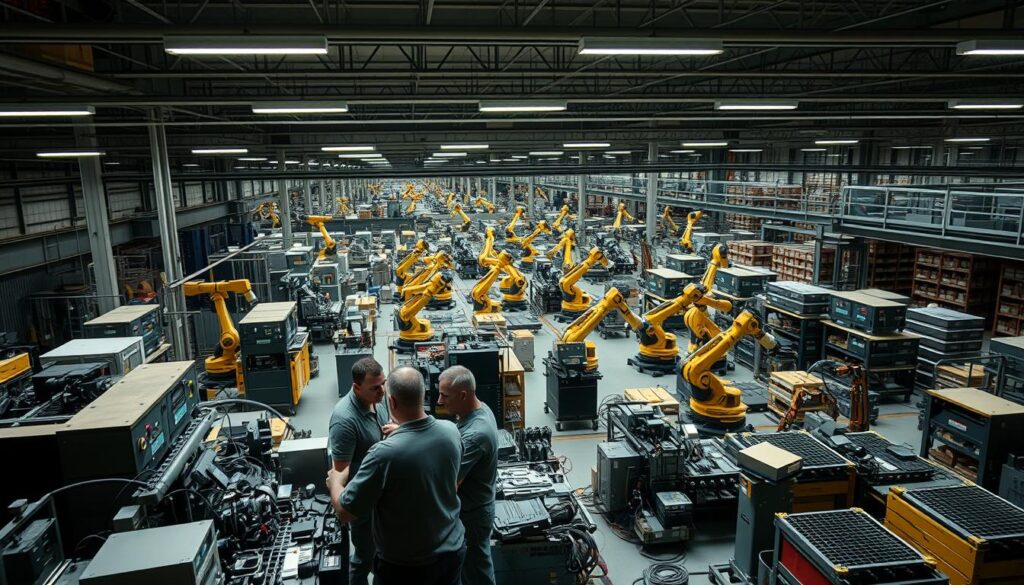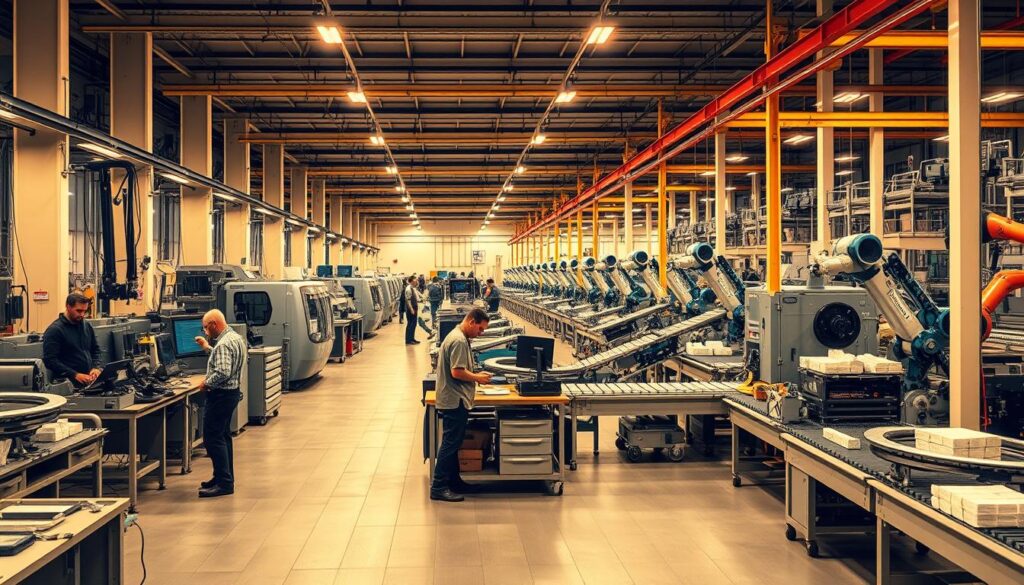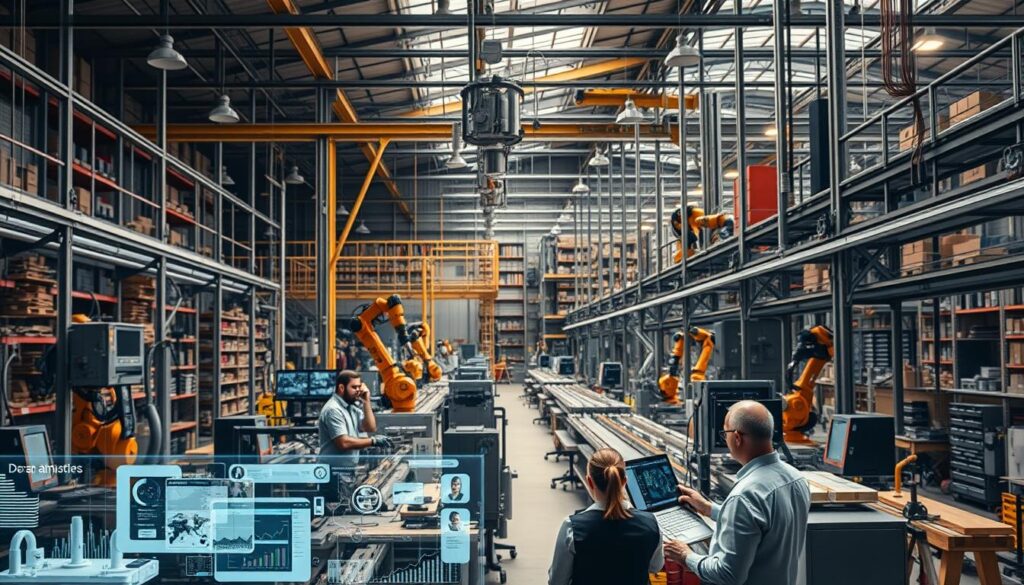Can optimizing manufacturing processes be the key to unlocking unprecedented efficiency in your production line?
Mastering production engineering is crucial for manufacturers aiming to improve product quality, reduce costs, and increase productivity. By understanding the intricacies of manufacturing processes, businesses can streamline their operations, leading to enhanced competitiveness in the market.
Efficient manufacturing processes are the backbone of any successful production line. By focusing on optimizing these processes, manufacturers can achieve significant improvements in their overall performance.
Key Takeaways
- Understanding the principles of production engineering is vital for optimizing manufacturing processes.
- Streamlining manufacturing processes can lead to improved product quality and reduced costs.
- Mastering production engineering enables businesses to increase productivity and competitiveness.
- Optimizing manufacturing processes is crucial for achieving operational efficiency.
- Focusing on production engineering can lead to significant improvements in overall business performance.
What is Production Engineering?
Production engineering encompasses a broad range of activities aimed at improving manufacturing efficiency and product quality. It involves the application of engineering principles to optimize manufacturing processes, ensuring that products are produced efficiently and to the required quality standards.
Definition and Scope
The definition of production engineering is closely tied to its role in industrial automation and quality management. It involves process design, production planning, and quality control, among other activities. Production engineers work to streamline manufacturing processes, reduce waste, and improve product quality.
The scope of production engineering is vast, covering everything from the initial design stages through to the final production and delivery of a product. It requires a deep understanding of both the manufacturing process and the materials being used.
Importance in Manufacturing
The importance of production engineering in manufacturing cannot be overstated. By optimizing production processes, manufacturers can significantly reduce costs and improve product quality. Effective production engineering also enables companies to respond more quickly to changes in demand or market conditions.
In today’s competitive manufacturing landscape, quality management is critical. Production engineering plays a key role in ensuring that products meet the required quality standards, thereby enhancing customer satisfaction and loyalty.
Key Principles of Production Engineering
Understanding the key principles of production engineering is crucial for manufacturers aiming to optimize their production processes and reduce costs. Production engineering encompasses a broad range of strategies and techniques designed to improve manufacturing efficiency and product quality.
Efficiency Optimization
Efficiency optimization is a critical component of production engineering, focusing on streamlining manufacturing processes to minimize waste and maximize productivity. Techniques such as lean manufacturing play a significant role in this area, helping manufacturers eliminate non-value-added activities and reduce production lead times.
Implementing process optimization strategies allows manufacturers to analyze and improve their production workflows, leading to significant gains in efficiency. This can involve the use of advanced analytics and simulation tools to model production processes and identify areas for improvement.
| Optimization Technique | Description | Benefits |
|---|---|---|
| Lean Manufacturing | Focuses on eliminating waste and maximizing value-added activities | Reduced lead times, lower costs |
| Process Simulation | Involves modeling production processes to identify improvements | Increased efficiency, reduced waste |
| Advanced Analytics | Utilizes data analysis to optimize production workflows | Data-driven decision making, improved productivity |
Cost Control Strategies
Effective cost control is essential for maintaining profitability in manufacturing. Production engineers employ various strategies to reduce production costs without compromising product quality. One key approach is to implement cost-saving technologies and processes that minimize waste and reduce energy consumption.
By applying cost control strategies, manufacturers can achieve significant savings and improve their bottom line. This involves closely monitoring production expenses, optimizing resource allocation, and investing in technologies that offer long-term cost benefits.

In conclusion, the key principles of production engineering, including efficiency optimization and cost control strategies, are vital for manufacturers seeking to improve their competitiveness and profitability. By understanding and applying these principles, manufacturers can achieve significant improvements in efficiency and cost savings.
Role of a Production Engineer
The role of a production engineer is multifaceted, encompassing a wide range of responsibilities that are crucial for the smooth operation of manufacturing processes. Production engineers are at the forefront of ensuring that production is carried out efficiently, effectively, and safely.
Responsibilities and Duties
Production engineers are tasked with designing, developing, and implementing manufacturing processes. Their duties include process planning, production planning, and quality control, ensuring that products meet the required standards. They are also responsible for analyzing manufacturing processes to identify areas for improvement and implementing changes to optimize production.
Some of the key responsibilities include:
- Developing and implementing manufacturing processes to improve efficiency
- Conducting quality control checks to ensure product quality
- Analyzing production data to identify trends and areas for improvement
- Collaborating with other departments to ensure smooth production flow
Skills Required
To be effective, production engineers require a range of skills, including technical knowledge, problem-solving abilities, and communication skills. They must be able to analyze complex manufacturing processes, identify problems, and develop practical solutions. Additionally, they need to be able to communicate effectively with other teams and stakeholders.
Some of the key skills required for production engineers include:
| Skill | Description |
|---|---|
| Technical Knowledge | Understanding of manufacturing processes and technologies |
| Problem-Solving | Ability to analyze problems and develop practical solutions |
| Communication | Effective communication with teams and stakeholders |
Tools and Technologies in Production Engineering
The integration of cutting-edge tools and technologies is transforming the landscape of production engineering. By leveraging these advancements, manufacturers can significantly enhance productivity, quality, and efficiency.

CAD Software
Computer-Aided Design (CAD) software is a fundamental tool in production engineering, enabling the creation of precise designs and models. CAD software allows engineers to simulate and analyze product performance, reducing the need for physical prototypes and speeding up the design process.
CAD software is used for designing and developing products, and its capabilities include 2D and 3D modeling, simulation, and rendering. Popular CAD software includes Autodesk Inventor, SolidWorks, and Fusion 360.
ERP Systems
Enterprise Resource Planning (ERP) systems are critical for managing production planning, inventory control, and supply chain management. ERP systems integrate various business functions, providing a unified view of the organization and enabling data-driven decision-making.
ERP systems help manufacturers optimize production workflows, reduce costs, and improve customer satisfaction. Key features of ERP systems include production planning, inventory management, and supply chain management.
Automation Tools
Automation tools, such as robotics and machine learning algorithms, are used to optimize manufacturing processes and improve efficiency. Industrial automation enables manufacturers to reduce labor costs, enhance product quality, and increase productivity.
Automation tools can be applied to various manufacturing processes, including assembly, inspection, and packaging. Examples of automation tools include robotic arms, conveyor systems, and machine vision systems.
Lean Manufacturing Concepts
Lean manufacturing is a methodology that aims to minimize waste while maximizing value-added activities in production processes. By understanding and implementing lean principles, manufacturers can achieve significant improvements in efficiency, productivity, and product quality.
Core Principles of Lean
The core principles of lean manufacturing revolve around identifying and eliminating non-value-added activities. This includes reducing excess inventory, overproduction, and unnecessary motion. By streamlining processes, manufacturers can lower costs and enhance overall performance.
- Value Specification: Defining value from the customer’s perspective is crucial.
- Value Stream Mapping: Identifying and mapping out the value stream to pinpoint waste.
- Flow Creation: Creating a smooth flow of processes to produce products without interruptions.
- Pull Production: Producing based on actual customer demand rather than forecasting.
- Perfection: Continuously improving processes to achieve perfection.
Waste Reduction Techniques
Waste reduction is a critical aspect of lean manufacturing. Techniques include:
- Identifying Waste: Recognizing the seven types of waste (transportation, inventory, motion, waiting, overproduction, overprocessing, and defects).
- Implementing Just-In-Time (JIT): Producing and delivering products just in time to meet customer demand.
- Continuous Improvement: Regularly assessing and improving processes to eliminate waste.
Lean manufacturing has been successfully adopted by various industries. For instance, companies like Toyota and Boeing have seen significant improvements in their production processes.
| Lean Principle | Description | Benefit |
|---|---|---|
| Value Specification | Defining value from the customer’s perspective | Aligns production with customer needs |
| Value Stream Mapping | Identifying and mapping the value stream | Pinpoints areas of waste |
| Flow Creation | Creating a smooth flow of processes | Reduces production time |
Six Sigma and Quality Control
Six Sigma is a data-driven approach that has revolutionized quality control in manufacturing processes. By focusing on defect reduction and variability, Six Sigma methodologies have become essential for companies aiming to improve their production quality.

Understanding Six Sigma
Six Sigma is a quality management methodology that uses statistical tools and techniques to measure and improve the quality of processes. It aims to reduce defects to as low as 3.4 per million opportunities, thereby enhancing customer satisfaction and reducing waste.
The implementation of Six Sigma involves several key steps, including defining the problem, measuring current processes, analyzing data, improving processes, and controlling new processes to prevent regression.
Tools for Quality Improvement
Several tools are utilized in Six Sigma for continuous improvement, including:
- DMAIC (Define, Measure, Analyze, Improve, Control): A data-driven cycle for improving processes.
- Root Cause Analysis: Identifying the underlying causes of problems.
- Statistical Process Control: Monitoring processes to detect deviations.
These tools help organizations achieve significant improvements in quality and efficiency, leading to enhanced customer satisfaction and reduced operational costs.
By adopting Six Sigma principles, manufacturers can achieve a competitive edge in the market by delivering high-quality products consistently. The focus on data-driven decision-making ensures that improvements are based on factual analysis rather than assumptions.
Integrating Sustainability in Production
Sustainability is no longer a buzzword; it’s a necessity in modern production engineering, driving eco-friendly practices and reducing environmental impact. As manufacturers strive to minimize their ecological footprint, integrating sustainable practices into production processes has become paramount.
One of the key strategies in achieving sustainability is through the adoption of eco-friendly practices. This includes reducing energy consumption, minimizing waste, and implementing recycling programs. By optimizing production processes, manufacturers can significantly lower their environmental impact while also reducing operational costs.
Eco-friendly Practices
Eco-friendly practices in production engineering encompass a wide range of activities. For instance, manufacturers can switch to energy-efficient lighting and machinery, reducing their energy consumption. Additionally, implementing lean manufacturing techniques can help minimize waste and optimize resource utilization.
Another critical aspect is the use of sustainable materials. This involves sourcing materials from suppliers who adhere to environmental standards, using recycled materials when possible, and designing products for recyclability and reuse.
Sustainable Materials
The selection of sustainable materials is crucial for reducing the environmental footprint of products. Manufacturers can opt for materials that are certified by environmental standards organizations. Furthermore, designing products with a lifecycle approach can help in minimizing waste and promoting recycling.
By integrating sustainability into production processes, manufacturers not only contribute to environmental conservation but also enhance their brand reputation and comply with increasingly stringent environmental regulations.
Advanced Manufacturing Technologies
The manufacturing landscape is undergoing a significant transformation with the advent of advanced manufacturing technologies. These technologies are not only enhancing productivity but also improving product quality and reducing production costs.
Additive Manufacturing
Additive manufacturing, commonly known as 3D printing, involves producing products layer by layer. This method allows for the creation of complex geometries that would be difficult or impossible to achieve with traditional manufacturing techniques. It also reduces material waste, making it a more sustainable option.
Benefits of Additive Manufacturing:
- Complex geometries without additional tooling costs
- Reduced material waste
- Customization capabilities
- Rapid prototyping

Robotics in Production
Robotics is being increasingly used in manufacturing to automate various processes, from assembly to inspection. Robotics improves efficiency, reduces labor costs, and enhances product quality by minimizing human error.
The integration of robotics in production involves:
- Automating repetitive tasks
- Enhancing precision and accuracy
- Improving workplace safety
| Technology | Benefits | Applications |
|---|---|---|
| Additive Manufacturing | Complex geometries, reduced waste | Aerospace, Healthcare, Automotive |
| Robotics | Improved efficiency, reduced labor costs | Assembly, Inspection, Packaging |
By adopting these advanced manufacturing technologies, manufacturers can achieve significant improvements in productivity and product quality, staying competitive in a rapidly evolving market.
Process Planning and Design
Process planning is a fundamental aspect of production engineering that directly impacts productivity. It involves the detailed planning of processes to manufacture products efficiently and effectively.
The importance of process design cannot be overstated. A well-designed process plan is crucial for process optimization, as it helps in identifying the most efficient methods of production, reducing waste, and improving product quality.
Importance of Process Design
Process design is critical because it lays the foundation for the entire production process. It involves analyzing the production requirements, selecting the appropriate manufacturing processes, and designing the production layout.
“The design of a process is not just about creating a sequence of operations; it’s about creating a system that is efficient, reliable, and flexible enough to adapt to changes in demand or design.” –
A good process design helps in reducing production costs, improving product quality, and increasing productivity. It also enables manufacturers to respond quickly to changes in market demand.
Making Efficient Production Flow
Creating an efficient production flow is essential for lean manufacturing. It involves streamlining processes, eliminating bottlenecks, and reducing waste.
The following table illustrates the key elements of efficient production flow:
| Element | Description | Benefit |
|---|---|---|
| Streamlined Processes | Simplifying production processes to reduce complexity | Increased Efficiency |
| Bottleneck Elimination | Identifying and resolving bottlenecks in production | Improved Productivity |
| Waste Reduction | Minimizing waste through efficient use of resources | Cost Savings |
By focusing on these elements, manufacturers can achieve a more efficient production flow, leading to improved productivity and reduced costs.
In conclusion, process planning and design are vital components of production engineering. By understanding the importance of process design and implementing efficient production flows, manufacturers can achieve significant improvements in productivity and efficiency.
Supply Chain Management in Production
Supply chain management is the backbone of production engineering, facilitating the smooth operation of manufacturing processes. It involves the coordination of activities from sourcing raw materials to delivering the final product to customers.

Overview of Supply Chains
A supply chain encompasses all the activities, resources, and organizations involved in the production and delivery of a product or service. It includes supply chain planning, procurement, production planning, and logistics management. Effective supply chain management ensures that products are delivered on time, in the right quantities, and at the required quality.
Best Practices for Supply Management
To optimize supply chain management, manufacturers can adopt several best practices. These include:
- Developing strategic supplier relationships to ensure a stable supply of high-quality materials.
- Implementing inventory management systems to minimize stockouts and overstocking.
- Utilizing data analytics to forecast demand and adjust production accordingly.
- Investing in supply chain visibility tools to track shipments and manage risks.
By adopting these best practices, manufacturers can improve their supply chain resilience, reduce costs, and enhance customer satisfaction.
Data Analytics in Production Engineering
The integration of data analytics in production engineering has revolutionized the way manufacturers approach quality management and continuous improvement. By leveraging data analytics, production engineers can gain valuable insights into production processes, identify areas of inefficiency, and implement data-driven solutions.
Role of Data in Decision Making
Data plays a crucial role in decision-making within production engineering. It enables engineers to move beyond intuition-based decisions and adopt a more informed approach. By analyzing data from various sources, including production lines, supply chains, and customer feedback, engineers can identify trends, predict outcomes, and make decisions that enhance product quality and reduce waste.
Key benefits of data-driven decision-making include:
- Improved product quality through precise defect detection and correction
- Enhanced efficiency by optimizing production workflows
- Reduced operational costs through minimized waste and energy consumption
Tools for Data Analysis
Several tools are available for data analysis in production engineering, ranging from simple spreadsheet software to advanced analytics platforms. Some of the most commonly used tools include:
| Tool | Description | Application in Production Engineering |
|---|---|---|
| Microsoft Excel | Spreadsheet software for data manipulation and basic analysis | Used for tracking production metrics and performing basic statistical analysis |
| Tableau | Data visualization tool for creating interactive dashboards | Helps in visualizing production data to identify trends and patterns |
| Python Libraries (Pandas, NumPy) | Programming libraries for advanced data analysis | Used for complex data analysis, predictive modeling, and data mining |
By adopting these tools and integrating data analytics into their workflows, production engineers can drive continuous improvement and achieve higher levels of efficiency and quality.
Challenges in Production Engineering
Despite its importance, production engineering is not without its hurdles, including equipment failures and supply chain disruptions. Manufacturers must navigate these challenges to maintain production efficiency and minimize downtime.
Common Issues Faced
Production engineers often encounter a range of issues, including:
- Equipment Failures: Machinery breakdowns can halt production, leading to significant losses.
- Supply Chain Disruptions: Delays or disruptions in the supply chain can impact production schedules.
- Quality Control Issues: Maintaining consistent quality is crucial, and deviations can lead to rework or waste.

Strategies for Problem Solving
To address these challenges, manufacturers can implement several strategies:
- Predictive Maintenance: Regular maintenance and monitoring can help prevent equipment failures.
- Diversifying Suppliers: Having multiple suppliers can mitigate the risk of supply chain disruptions.
- Continuous Quality Monitoring: Implementing real-time quality control measures can help identify and rectify issues promptly.
By adopting these strategies, manufacturers can enhance their resilience to production engineering challenges and maintain a competitive edge.
Career Opportunities in Production Engineering
The field of production engineering is rapidly expanding, providing numerous career avenues for professionals. As a crucial aspect of modern manufacturing, it encompasses a broad range of activities, from designing and developing manufacturing processes to managing production systems.
Job Roles and Industries
Production engineers can be found in various industries, including manufacturing, aerospace, automotive, and electronics. Their roles can vary significantly, from process planning and design to implementation and management of manufacturing systems.
Some common job roles for production engineers include:
- Manufacturing Engineer
- Production Manager
- Process Engineer
- Operations Manager
- Quality Engineer
These roles involve working on process optimization, cost reduction, and quality improvement. Production engineers use their knowledge of manufacturing processes and technologies to drive efficiency and productivity.
Future Trends and Insights
The future of production engineering is closely tied to advancements in technology, including automation, artificial intelligence (AI), and additive manufacturing. These technologies are transforming manufacturing processes, making them more efficient and flexible.
| Trend | Description | Impact |
|---|---|---|
| Automation | Increased use of robots and automated systems | Improved efficiency and reduced labor costs |
| AI in Manufacturing | Application of AI for predictive maintenance and quality control | Enhanced productivity and reduced downtime |
| Additive Manufacturing | Use of 3D printing for complex product manufacturing | Increased product complexity and reduced material waste |
As production engineering continues to evolve, professionals in this field must stay abreast of these trends to remain competitive. By embracing new technologies and methodologies, production engineers can drive innovation and success in their organizations.
Continuous Improvement in Production Processes
The key to sustained success in production engineering lies in the commitment to continuous improvement. In today’s competitive manufacturing landscape, companies must continually assess and refine their production processes to stay ahead.

Importance of Continuous Learning
Continuous learning is the foundation upon which continuous improvement is built. It involves ongoing training and education for employees to enhance their skills and adapt to new technologies and methodologies. By fostering a culture of continuous learning, organizations can improve efficiency, reduce waste, and enhance product quality.
Some key benefits of continuous learning include:
- Innovation through new skills and knowledge
- Improved employee engagement and retention
- Better adaptation to technological advancements
Tools for Improvement
Several tools and methodologies can facilitate continuous improvement in production processes. Lean manufacturing is one such approach that focuses on minimizing waste and maximizing value-added activities. Other tools include:
| Tool/Methodology | Description | Benefits |
|---|---|---|
| Lean Manufacturing | Focuses on reducing waste and improving efficiency | Reduced costs, improved quality |
| Six Sigma | Data-driven approach to quality management | Improved quality, reduced variability |
| Kaizen | Continuous improvement through small, incremental changes | Increased efficiency, employee engagement |
By leveraging these tools and maintaining a commitment to continuous improvement, manufacturers can achieve significant gains in productivity and competitiveness.
Educational Pathways in Production Engineering
A career in production engineering is built on a strong educational background in engineering or related fields. To excel in this role, individuals must acquire the right education and training.
Required Degrees and Certifications
Production engineers typically require a bachelor’s degree in engineering, such as mechanical engineering, industrial engineering, or manufacturing engineering. Some positions may require a master’s degree or specialized certifications like Lean Manufacturing or Six Sigma.
- A bachelor’s degree in a relevant engineering field
- Certifications in Lean Manufacturing or Six Sigma
- Advanced degrees for senior or specialized roles
Certifications can significantly enhance a production engineer’s career prospects by demonstrating expertise in quality management and process optimization.
Recommended Programs and Schools
Several institutions offer strong programs in production engineering. Some of the top schools include:
- Massachusetts Institute of Technology (MIT)
- Stanford University
- University of Michigan
These programs often include coursework in production systems, manufacturing processes, and quality control, providing a comprehensive education in production engineering.
By choosing the right educational pathway, aspiring production engineers can gain the knowledge and skills needed to succeed in this dynamic field.
Conclusion: The Future of Production Engineering
As production engineering continues to evolve, manufacturers must stay ahead of the curve to remain competitive. The increasing use of industrial automation, AI, and data analytics is transforming the manufacturing landscape, enabling significant improvements in efficiency, productivity, and product quality.
Emerging Trends
Trends to watch include the growing adoption of additive manufacturing, robotics, and the Internet of Things (IoT). These technologies are revolutionizing production processes, allowing for greater flexibility, precision, and customization.
Mastering Production Engineering
To master production engineering, professionals must stay up-to-date with the latest developments and technologies. By doing so, they can optimize production processes, reduce costs, and improve product quality. Effective production engineering is crucial for manufacturers seeking to remain competitive in a rapidly changing global market.
